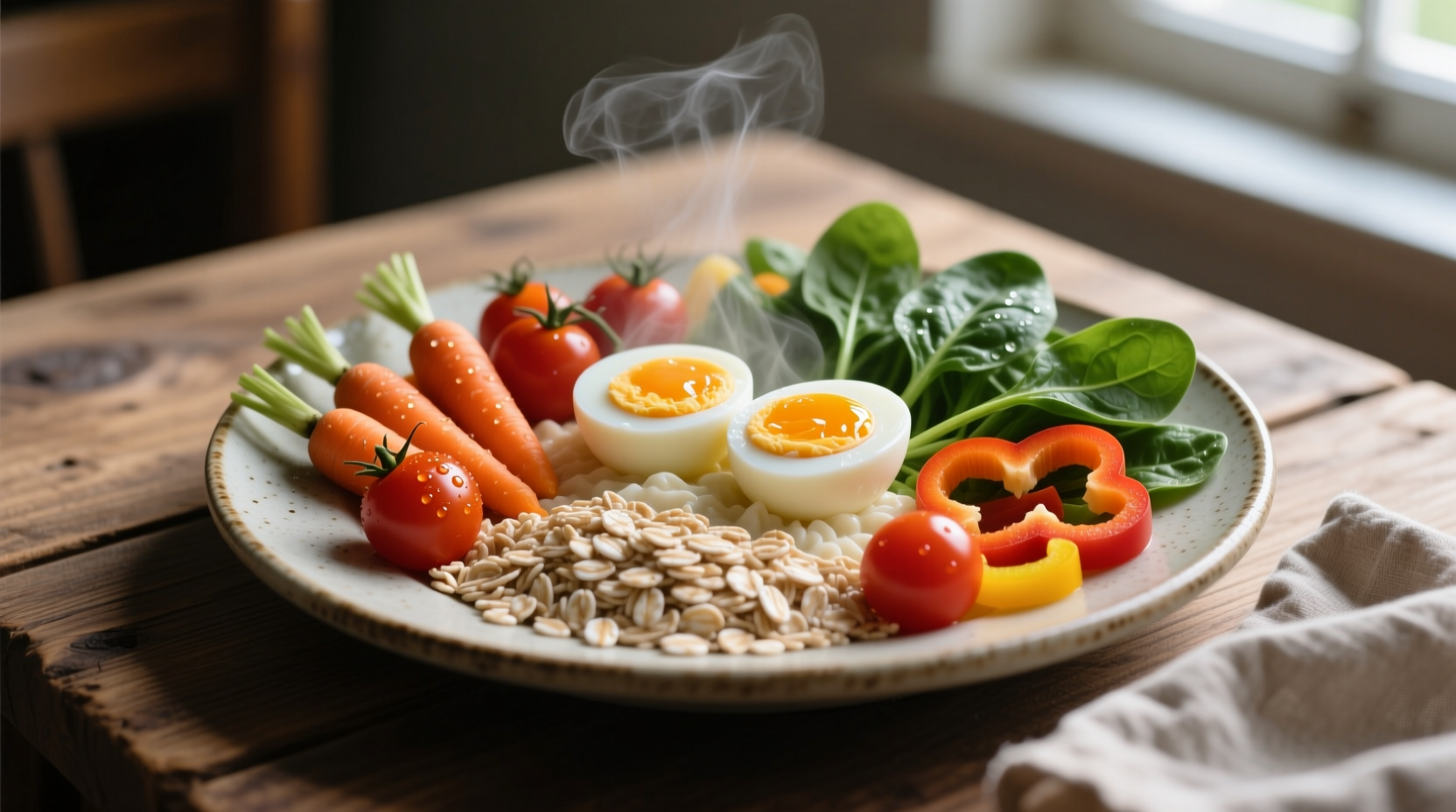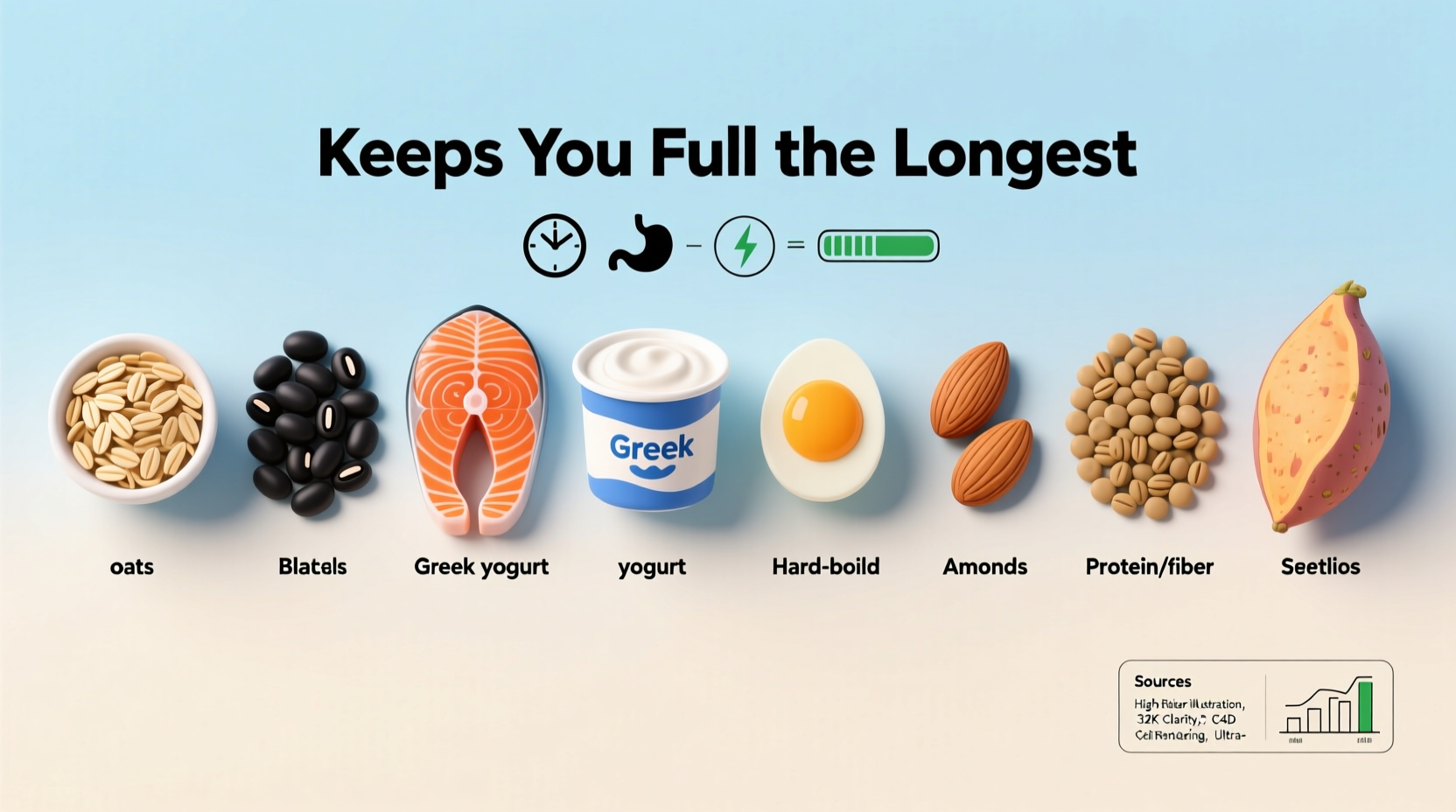Protein-rich foods like boiled eggs, lean meats, and legumes, high-fiber options such as oats and beans, and water-dense vegetables like broccoli and soups keep you full the longest. These foods score highest on the satiety index, with boiled potatoes ranking #1 (300% more filling than white bread). Combining protein, fiber, and healthy fats creates meals that maintain fullness for 4-6 hours.
Ever finish a meal only to feel hungry again an hour later? You're not alone. Understanding what foods keep you full the longest is crucial for managing hunger, supporting weight goals, and maintaining stable energy throughout your day. The secret lies in a food's ability to trigger satiety signals while providing sustained energy release.
The Science Behind Long-Lasting Fullness
Researchers measure satiety using the satiety index—a scale comparing how well different foods curb hunger relative to white bread. Australian nutrition scientist Dr. Susanna Holt's landmark study tested 38 foods and revealed key patterns. Foods scoring highest share three critical properties:
| Factor | Impact on Fullness | Top Food Examples |
|---|---|---|
| Protein content (≥15g per meal) | Triggers appetite-suppressing hormones | Eggs, Greek yogurt, lean chicken |
| Dietary fiber (≥5g per serving) | Slows digestion, adds bulk | Oats, lentils, chia seeds |
| Water content (≥80%) | Increases volume without calories | Broth-based soups, cucumbers, watermelon |
These elements work together through gastric distension (stomach stretching), hormonal signaling (GLP-1, PYY), and slow nutrient absorption. Foods combining all three factors keep you satisfied significantly longer than those focusing on just one.
Top 7 Longest-Lasting Satiating Foods (Backed by Research)
1. Boiled Potatoes (Satiety Index: 323%)
Surprisingly, boiled potatoes rank #1 in Holt's research—more than three times as filling as white bread. Their high resistant starch content resists digestion, feeding beneficial gut bacteria while slowing glucose release. Pro tip: Let cooled potatoes sit refrigerated for 12 hours to increase resistant starch by 50%.
2. Oatmeal (Satiety Index: 209%)
Steel-cut oats outperform instant varieties due to their minimal processing. A 2022 American Journal of Clinical Nutrition study found participants eating steel-cut oats consumed 31% fewer calories at their next meal compared to those eating sugary cereals. The beta-glucan fiber forms a viscous gel that delays stomach emptying.
3. Lentils and Legumes (Satiety Index: 133-185%)
With 18g protein and 15g fiber per cooked cup, lentils create powerful fullness. Research from the American Heart Association shows regular legume consumption correlates with 22% lower risk of obesity. Their low energy density means you eat larger portions for fewer calories.
4. Eggs (Satiety Index: 150%)
A landmark study published in Nutrition Research tracked women eating either egg or bagel breakfasts with equal calories. The egg group felt fuller for 4+ hours and consumed 400 fewer daily calories. Eggs' complete protein profile contains all nine essential amino acids that optimize satiety hormone production.
5. Greek Yogurt (Satiety Index: 118-160%)
With double the protein of regular yogurt (17g per 6oz), Greek yogurt's thickness slows gastric emptying. A National Institutes of Health analysis found high-protein dairy consumption associated with 12% greater fullness duration compared to low-protein alternatives.
6. Broth-Based Soups (Satiety Index: 130-180%)
Starting meals with broth-based soups increases fullness by 26% according to research in Appetite journal. The water volume triggers stretch receptors while the warmth enhances gastric signaling. Avoid cream-based soups which lack the same satiety benefits.
7. Chia and Flax Seeds (Satiety Index: 140-170%)
These tiny seeds absorb 10-12x their weight in water, forming a gel that slows digestion. Just two tablespoons provide 5g fiber and 3g protein. A FDA-reviewed study confirmed chia seeds' role in promoting fullness and reducing subsequent food intake.
Strategic Food Pairing for All-Day Fullness
Maximize satiety by combining elements from different food groups. The most effective combinations follow this formula:
- Protein + Fiber: Scrambled eggs with spinach (22g protein, 4g fiber)
- Fiber + Healthy Fat: Apple slices with almond butter (5g fiber, 9g fat)
- Protein + Water: Chicken soup with added vegetables
A 2023 study in Obesity tracked participants eating meals with varying macronutrient combinations. Those consuming balanced protein-fiber-fat meals maintained fullness 37% longer than those eating single-component meals. The research team noted: "The synergistic effect creates prolonged gastric emptying and stable blood sugar—key factors in sustained satiety."

When Satiety Foods Fall Short: Context Matters
Even the most filling foods have limitations depending on context:
- Processing level: Instant oats lose 40% of their satiety power compared to steel-cut due to faster digestion
- Portion size: A single boiled potato keeps you full longer than mashed potatoes with added butter and milk
- Individual differences: People with insulin resistance may find protein more satiating than high-fiber carbs
- Eating speed: Consuming even high-satiety foods quickly reduces fullness signals by 30% (per Journal of Clinical Endocrinology & Metabolism)
Practical Implementation Guide
Transform your eating patterns with these science-backed strategies:
Breakfast That Lasts Until Lunch
Combine 2 eggs with ½ cup black beans and avocado slices. This provides 25g protein, 15g fiber, and healthy fats. Research shows this combination maintains fullness for 5+ hours—significantly longer than cereal or toast-based breakfasts.
Lunch Formula for Afternoon Energy
Mix 3oz grilled chicken with 1 cup quinoa and roasted vegetables. Add lemon-tahini dressing for healthy fats. This meal scores 192 on the satiety index—nearly double a typical deli sandwich.
Smart Snacking Strategy
When hunger strikes between meals, choose snacks combining at least two satiety factors:
- Carrot sticks with hummus (fiber + protein)
- Plain Greek yogurt with chia seeds (protein + fiber)
- Apple with a small handful of almonds (fiber + healthy fat)
Avoid single-component snacks like fruit alone or crackers, which provide temporary fullness but lead to quicker hunger return.
Debunking Common Satiety Myths
Not all "filling" foods deliver long-lasting results. Research reveals these surprising truths:
- Myth: All high-fat foods keep you full longer
Truth: While healthy fats contribute to satiety, foods like fried foods or pastries combine fat with refined carbs that spike blood sugar, leading to quicker hunger return - Myth: "Diet" foods satisfy hunger better
Truth: Artificially sweetened products often disrupt hunger signaling. A Nature study found regular diet soda drinkers had 21% weaker satiety response to real sugar - Myth: Eating more frequently prevents hunger
Truth: Grazing can blunt natural hunger/fullness signals. Most research supports 3-4 substantial meals with adequate protein and fiber for optimal satiety regulation
Your Satiety Success Plan
Implement these evidence-based steps to maximize fullness:
- Start meals with water-rich foods: Begin lunch with broth-based soup or salad
- Include 20-30g protein per meal: This threshold optimizes satiety hormone production
- Choose minimally processed options: Steel-cut oats over instant, whole potatoes over mashed
- Chew thoroughly: Aim for 20-30 chews per bite to enhance fullness signaling
- Wait 20 minutes before seconds: It takes this long for fullness signals to reach your brain
Remember that individual responses vary—track your hunger levels after different meals for one week to identify your personal satiety champions. The most effective foods that keep you full the longest are those you enjoy and can consistently incorporate into your eating pattern.











 浙公网安备
33010002000092号
浙公网安备
33010002000092号 浙B2-20120091-4
浙B2-20120091-4